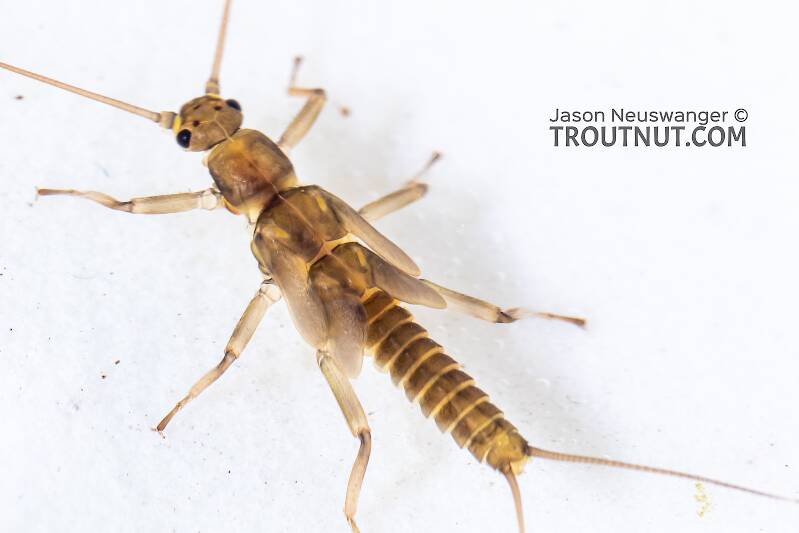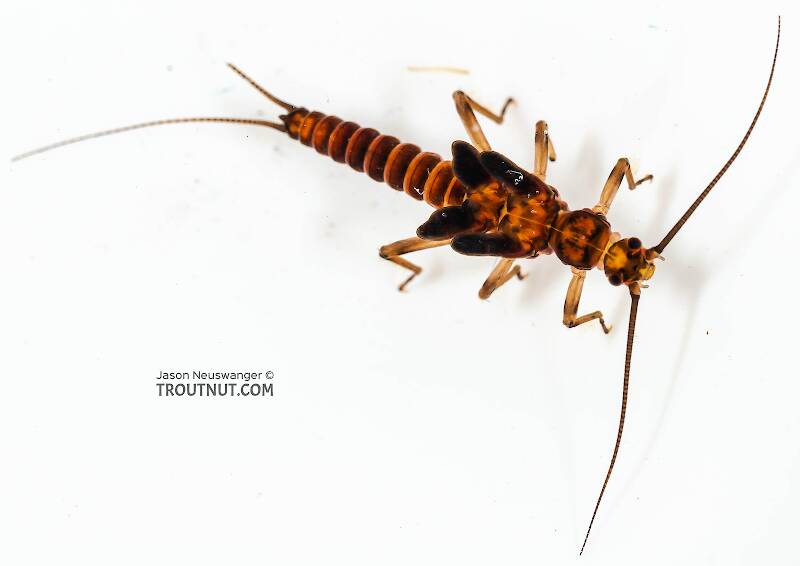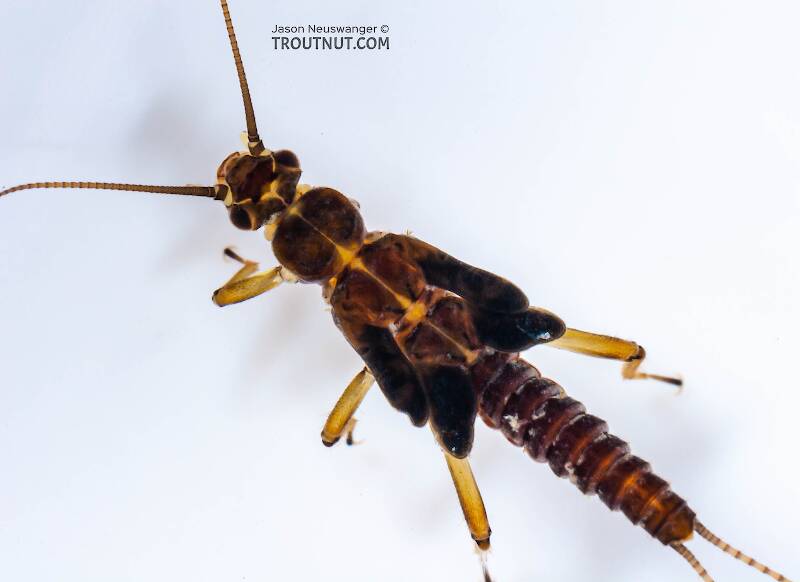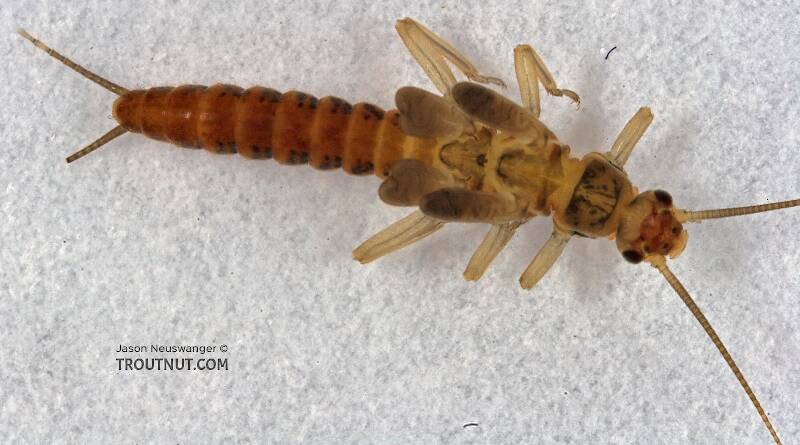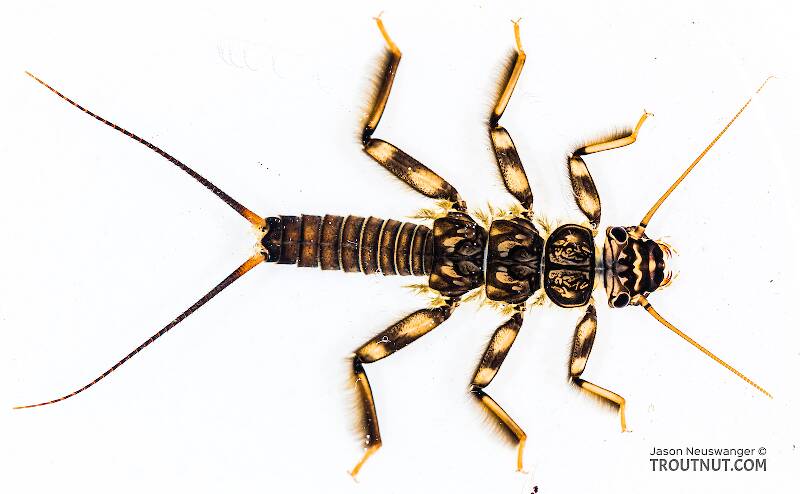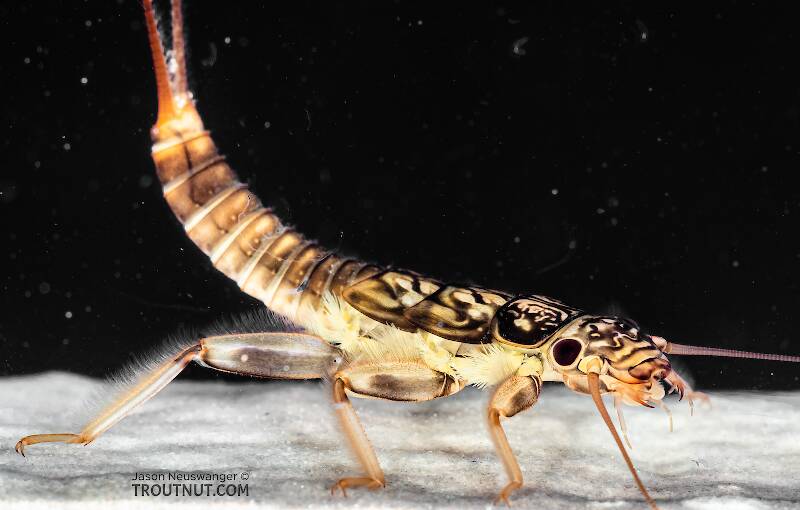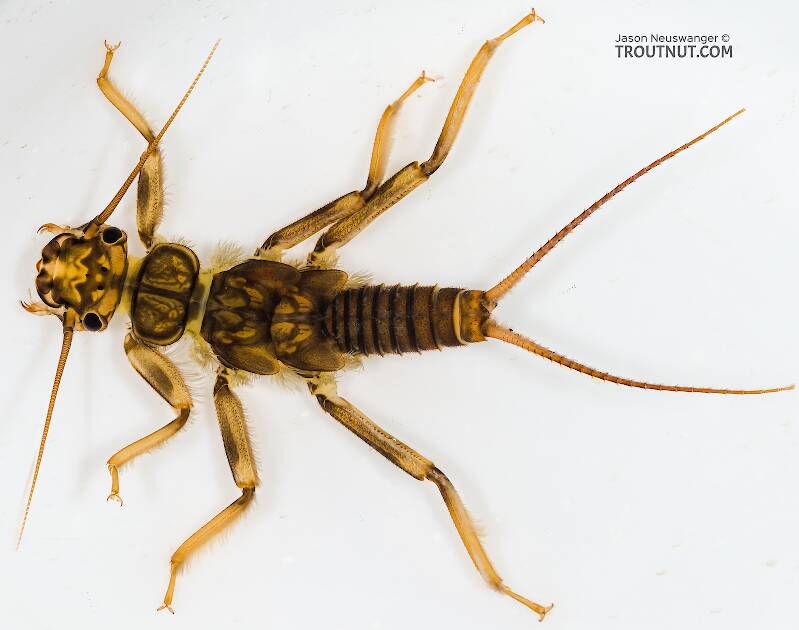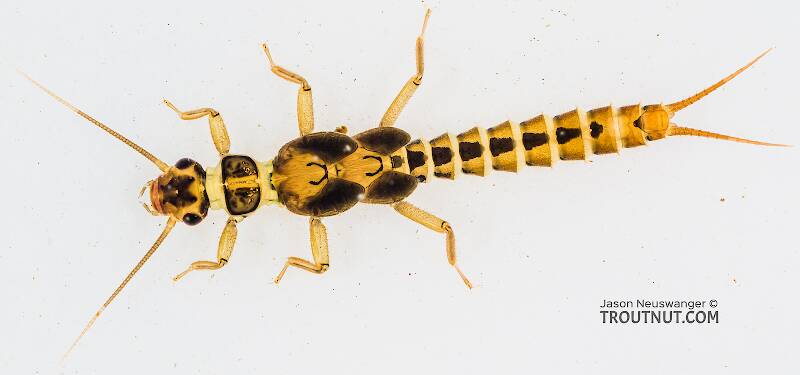
Blue-winged Olives
Baetis
Tiny Baetis mayflies are perhaps the most commonly encountered and imitated by anglers on all American trout streams due to their great abundance, widespread distribution, and trout-friendly emergence habits.
Featured on the forum

Troutnut is a project started in 2003 by salmonid ecologist Jason "Troutnut" Neuswanger to help anglers and
fly tyers unabashedly embrace the entomological side of the sport. Learn more about Troutnut or
support the project for an enhanced experience here.
Identification: Key to Families of Stonefly Nymphs, Couplet 3
Identification: Key to Families of Stonefly Nymphs, Couplet 3
Error: Tried to access a key that isn't live.
Adapted from Merritt R.W., Cummins, K.W., and Berg, M.B. (2019)
This couplet refers figures (usually designated 'sf') from this source.
You will need the source (make sure to get the same edition!) to see them.
This couplet refers figures (usually designated 'sf') from this source.
You will need the source (make sure to get the same edition!) to see them.
These mouthparts are typically easy enough to see under a microscope, but the need for optics (except on the largest specimens) makes this an unfortunately difficult couplet for anglers so early in the key. It is often possible to skip this couplet by recognizing the general distinctive shapes and colors of the families, as Perlidae and Perlodidae look very different (with various distinctive yellow and dark brown/black color patterns) from Taeniopterygidae and Nemouridae (with wingpads angled out to create a triangular appearance, and typically duller, more uniform brownish colors). The relatively difficult task for which mouth parts might be required here (although it's still possible at a glance, with experience) is distinguishing between the skinny little nymphs of Chloroperlidae and those of Capniidae and Leuctridae.
| Option 1 | Option 2 |
|---|---|
Paraglossae and glossae extend forward about the same distance (sf 16.18) (be careful not to confuse them with the labial palps, which might be large and partially obscuring these parts, as in the illustration)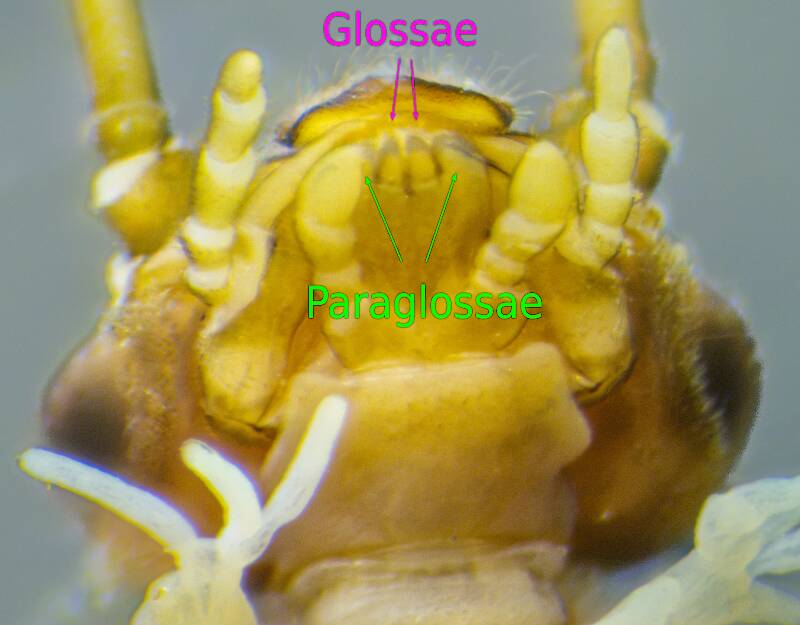
| Paraglossae much longer than glossae 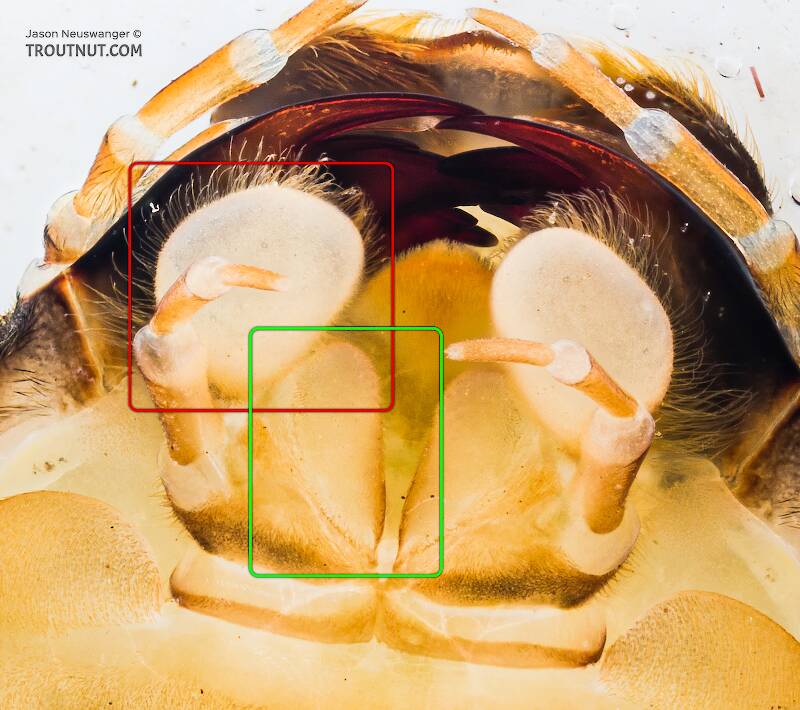
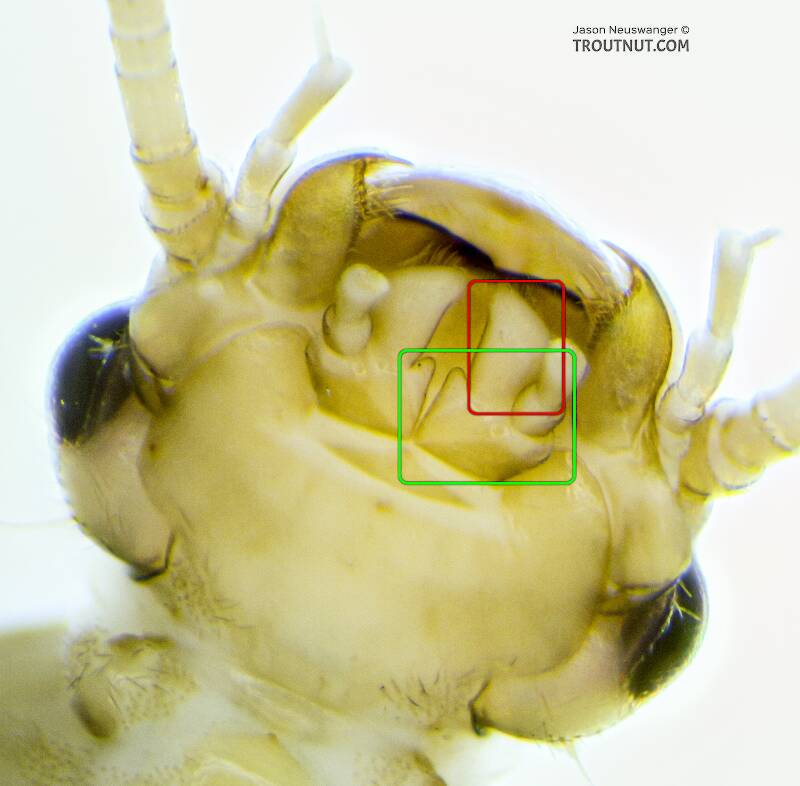
|
| Remaining families: Capniidae, Leuctridae, Nemouridae, and Taeniopterygidae | Remaining families: Chloroperlidae, Perlidae, and Perlodidae |
5 Example Specimens | 5 Example Specimens |
| Go to Couplet 4 | Go to Couplet 7 |
Adapted from Merritt R.W., Cummins, K.W., and Berg, M.B. (2019)
The current couplet is highlighted with darker colors and a icon, and couplets leading to this point have a icon.
Leads to Pteronarcyidae:
- Ventral gill tufts present on thorax and abdominal segments 1-2 or 1-3
Leads to Couplet 2:
- Ventral gill tufts absent from abdominal segments 1-2 or 1-3
Couplet 2
Leads to Peltoperlidae:
- Single, double, or forked conical gills present at least behind coxae of second and third leg
- Thoracic sterna posteriorly produced, overlapping succeeding segment
- Some genera appear roach-like
Leads to Couplet 3:
- Gills, if present, not conical
- Thoracic sterna not overlapping
Couplet 3
Couplet 3 (You are here)
Leads to Couplet 4:
- Paraglossae and glossae extend forward about the same distance (sf 16.18) (be careful not to confuse them with the labial palps, which might be large and partially obscuring these parts, as in the illustration)
Couplet 4
Leads to Couplet 7:
- Paraglossae much longer than glossae
Couplet 7
Leads to Taeniopterygidae:
- First and second tarsal segments near equal in length
- Midline of wing pads strongly divergent from body axis
- One genus often with each coxa bearing a single, segmented, ventrally directed, finger-like gill (sf 16.20) or abdomen terminating in a large, ventral, shield-like plate (sf 16.53)
Leads to Couplet 5:
- Second tarsal segment much shorter than first
- Midline of wing pads parallel or divergent
- No coxal finger-like gills nor large ventral, shield-like plate
Couplet 5
Leads to Nemouridae:
- Midline of metathoracic wing pads strongly divergent from body axis
- Usually robust and squat body, such that extended hind legs reach about to the tip of the abdomen
- Cervical gills present (sf 16.22-16.25) or absent
Leads to Couplet 6:
- Midline of metathoracic wingpads, if present, nearly parallel with body axis (sf 16.11-16.12)
- Elongate body, such that extended hind legs reach far short of the tip of the abdomen
- No cervical gills
Couplet 6
Leads to Capniidae:
- Postmentum small, its anterior portion not covering bases of maxillae (sf 16.26)
- Terga and sterna of abdominal segments 1-9 separated by membraneous pleural fold (sf 16.28)
- Abdominal segments widest posteriorly
- Hind wingpads about as broad as long (sf 16.30-16.31), reduced, or absent
- Abdominal terga always with a posterior setal fringe (sf 16.32)
Leads to Leuctridae:
- Postmentum large, with its anterior portion partially covering basis of maxillae (sf 16.27)
- At most, abdominal segments 1-7 separated by membraneous pleural fold (sf 16.29)
- Abdominal segments uniformly cylindrical
- Hind wing pads usually longer than wide (sf 16.12)
- Abdominal terga of some genera (Despaxia, Perlomyia, Paraleuctra, and Zealuctra) without a posterior setal fringe
Leads to Chloroperlidae:
- Apical maxillary palpal segment small, asymmetrically set on penultimate segment
- Tails 3/4 or less the length of the abdomen
- Head and thoracic terga usually without a distinct pattern of dark and light pigments
Leads to Perlodidae:
- Apical maxillary palpal segment subequal in length to penultimate segment and symmetrically attached
- Tails more than 3/4 the length of the abdomen
- Head and thoracic terga usually with a distinct pattern of dark and light pigments
Start a Discussion of this Couplet
References
- Baumann, Richard W. 1975. Revision of the Stonefly Family Nemouridae (plecoptera) : a Study Of The World Fauna At The Generic Level. Smithsonian Contributions to Zoology undef(211): 1-74.
- Merritt R.W., Cummins, K.W., and Berg, M.B. 2019. An Introduction to the Aquatic Insects of North America (Fifth Edition). Kendall/Hunt Publishing Company.




